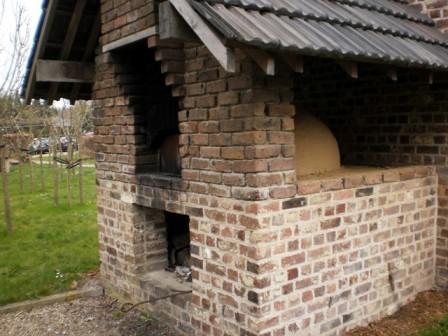The simplest oven is a mud tunnel. On a clay surface you model a (little) sand mountain in igloo shape or oblong. The top should be a dome shape. Cover the sand with clay. The door is a shelf (or braid) that is also covered with clay. The loam should contain about 15 to 20% clay.
 You can test this by dissolving the loam completely in water and then let it rest. The easiest way is a jar of clear glass. After some time you will see how the solid particles sink in layers of different color (and weight): first (gravel, then) sand, loam or clay (and then water). The clay layer should be about 1/5th of the loam and sand layer, otherwise you mix in more sand.
You can test this by dissolving the loam completely in water and then let it rest. The easiest way is a jar of clear glass. After some time you will see how the solid particles sink in layers of different color (and weight): first (gravel, then) sand, loam or clay (and then water). The clay layer should be about 1/5th of the loam and sand layer, otherwise you mix in more sand.
The door you cut out when the clay begins to dry. Trough this hole you take the sand out.
You can also build the igloo or tunnel with spheres, like snowballs molded from clay. Sometimes it is easy to do crafts as footwork... (like kneading). Each layer is slightly smaller. After completion finish and seal it smooth with clay layers all over the oven.
Formerly, every farm had his own bakery. Sometimes there was a communal oven in the village. The first were also of clay. To operate easily, the oven floor was built at table height. On oak beams came a layer of clay as a seal, on this a layer of sand as insulation, and then the hotplates in mud (loam). For example, 4 layers loam of 2 cm, the second only when the first was dried.
This easy height is necessary because the oven must be filled quickly after firing or he cools to much through the open door. It had to be done quickly: shoveling ashes out or sweeping to the side, possibly cleaning the oven, all breads are quickly shoot in because the first is baking before the last is in!
There are also models which are fired under the oven. Then, the underside, of course, also must be made as a dome, and there must be a chimney exit at the rear. The other most common furnaces we call direct fired furnaces : firing and baking is done in the same room.
Many freestanding ovens had no chimney. Therefore the oven mouth soon looks blackened.
Others have over the door a large mouth with a chimney. That mouth can be made more than large enough to smoke meat or fish.
They are fired hot enough with the door open (for air supply).
Same dome shape can also be made in bricks. The full bricks made of clay and baked at 900° -1100⁰C, can easily tolerate temperatures up to 500⁰.
You can also use refractory bricks and cement (resistant to 1,260⁰ - 1,430⁰) but that is not really necessary.
I have a chimney that was masoned with clay. Which is now (by using it) baked harder than the bricks. If you can bake from clay fireproof pottery in a loam oven, then clay and loam are certainly appropriate materials for a bread oven.
Also a brick dome (possibly after insulation with refractory material) is covered with clay. The intermediate layer of insulation can also be made by mixing loam with straw (loam 56 kg, 12.5 kg of lime and 4 kg of straw). The straw increases insulation value significantly. Don’t press this airy layer.
It is important that the used materials not only withstand high temperatures, but also to temperature changes. Probably you will have to slush cracks regularly with loam. I used some salt by kneading the clay or loam to prevent it from cracking. I don’t know if that helped. It’s what my father knew of his father.
Also important is that there are no toxic substances are released from the material when heated. This also applies to the fuel. (No painted wood,..)
Nowadays an oven is usually built with refractory bricks and refractory cement.
A usually freestanding roof protects the mud dome from rain.
The bakery stood apart from the other buildings because of fire hazard.
The brick oven that we had at home was however built in a shed at the house.
Let a new oven dry long enough. First heat a small fire in it. After a few times each time a bigger one, so everything can dry and harden.
